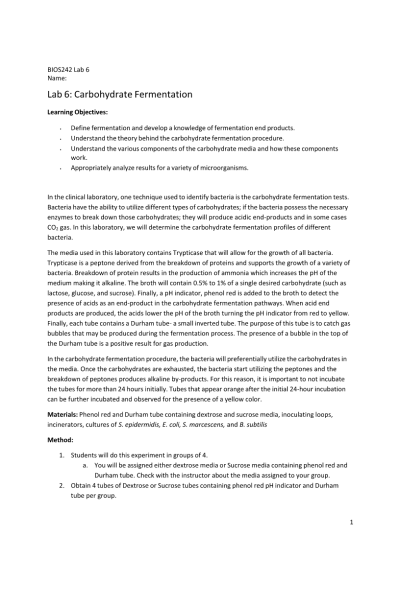BIOS 242 Week 3 Lab 2; Carbohydrate Fermentation
-
$20.00
| Institution | BIOS 242 Fundamentals of Microbiology with Lab - Chamberlain |
| Contributor | Anika Fultz |
Lab 6: Carbohydrate Fermentation
Learning Objectives:
- Define fermentation and develop a knowledge of fermentation end products.
- Understand the theory behind the carbohydrate fermentation procedure.
- Understand the various components of the carbohydrate media and how these components
work.
- Appropriately analyze results for a variety of microorganisms.
In the clinical laboratory, one technique used to identify bacteria is the carbohydrate fermentation tests. Bacteria have the ability to utilize different types of carbohydrates; if the bacteria possess the necessary enzymes to break down those carbohydrates; they will produce acidic end-products and in some cases CO2 gas. In this laboratory, we will determine the carbohydrate fermentation profiles of different bacteria.
Materials: Phenol red and Durham tube containing dextrose and sucrose media, inoculating loops, incinerators, cultures of S. epidermidis, E. coli, S. marcescens, and B. subtilis
Method:
- Students will do this experiment in groups of 4.
- Obtain 4 tubes of Dextrose or Sucrose tubes containing phenol red pH indicator and Durham tube per group.
- Label each tube with each of the bacteria listed in the materials section.
- Inoculate each tube with the appropriate bacteria using aseptic techniques.
- Incubate each tube at 37 ◦C for 18-24 hours.
- Keep the tubes closed and make observations using closed tubes only.
- Read and record your observations in the lab report.
- Get results from other groups in your class for the other media and record the observations in the lab report and complete the report.
- In the table in the Results section, “A” represents acidic end-products, “+” represents gas formation, and “-“ represents no change.
Lab Report:
Purpose: Please describe in complete sentences and in your own words, the purpose of this experiment.
The purpose of this experiment was to be able to use a technique that is used to identify bacteria through a fermentation test. Different carbohydrates are used, after inoculation we incubate the test tubes. This is meant to tell us whether the bacteria has the enzymes to break down the carbohydrates, if it does then the products will be acidic.
Results:
Questions:
- What is the purpose of the trypticase in the broth and why is this important? Be specific.
- Please describe the fermentation profile of the bacteria used in the procedure.
- If the media is orange instead of yellow, the tube should be incubated an additional 24 hours. Please explain why the additional incubation is needed.
- You inoculate a Dextrose broth with an organisms known to ferment dextrose. After 18-24 hours, there is no change in the broth. Please explain at least two possibilities for the lack of results.
| Instituition / Term | |
| Term | Uploaded 2023 |
| Institution | BIOS 242 Fundamentals of Microbiology with Lab - Chamberlain |
| Contributor | Anika Fultz |















































